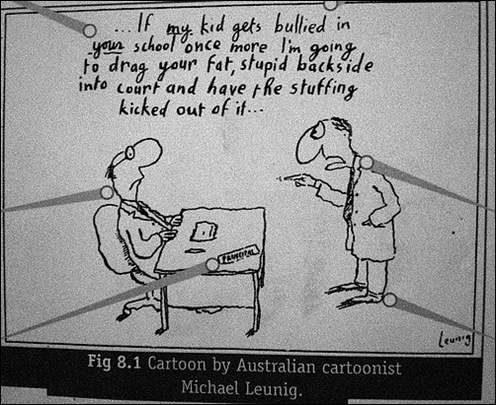In answering a recent comment I found the following site from Monash University. It is very good.
Monthly Archives: May 2009
Looking at a visual text
This is something I prepared to help a student in Year 11 ESL, but I find it is also helpful for others. I am indebted to Paul Grover’s excellent Visual Texts (2004), part of the Australian Heinemann English Project.

Writing about a text
An old way is to ask: WHO is saying WHAT to/for WHOM, WHEN, WHERE, WHY and HOW?
Here is a different version of that.
1. WHAT? – content, text type. You should mention the composer too.
2. WHO? (Could be different from the composer)
3. HOW?
4. To or for WHOM? WHY? WHEN? WHERE? – questions about the composer and responder relationship, and purpose and context.
5. AND SO…? Interpretation and evaluation.
Example: Leunig cartoon on bullying
The text is a cartoon by Michael Leunig. At the top are four lines of text in handwriting. The bottom half of the cartoon has two people. One is at a desk and the other is standing. The seated person is identified as a school principal. The other person is an angry parent.
The speaker in the cartoon is the person standing on the right. We know this because he is drawn with his mouth open and his finger pointing at the principal on the left.
The words spoken are centred at the top of the cartoon. This makes sure readers begin with the words, because the whole point of the cartoon is in these words. The speaker is using bullying language which is unlikely for a parent talking to a principal: “I’m going to drag your fat, stupid backside into court…” People are usually polite and respectful when they talk to a principal. It is ironic that someone complaining about bullying is being a bully himself.
The drawing underlines the dialogue. The principal is drawn seated behind his desk. Leunig usually suggests people’s age and job or status by caricature, and the principal is drawn with glasses and a bald head. His suit and tie are neat. The parent is drawn leaning forward with his finger jabbing. The movement of the finger is represented by a couple of curved lines. His eyes seem angry and his coat and tie are untidy.
This cartoon would not really interest children. It is for adults, possibly around the same age as the people in the drawing. A responder needs to have cultural knowledge about the way people usually behave when a parent speaks to a school principal. The humour comes because what we see is not what we usually expect in this situation. It is possible the cartoon appeared at a time when problems of school bullying were in the news.
The cartoon is about two things. First it is about bullying. It seems to be saying that adults who are themselves bullies set an example which school bullies follow. Second, it is about power relations. Usually it is the principal who has power in situations like this, and the parent who is requesting something. In both cases the role reversal shown in the cartoon makes the message humorously rather than heavily, but because the cartoon is making a serious point about a social problem it could be called a satirical cartoon. Making us smile may be a more effective way of getting us to think about the problem.
Typical HSC questions
For the Year 11 ESL course I have imagined an area study on POWER.
ESL Paper 1 Question 1 example 1
1. What is the purpose of this text? (1 mark)
2. Describe TWO techniques used to achieve that purpose? (2 marks)
ESL Paper 1 Question 1 example 2
1. Explain ONE idea about power in this cartoon? (1 mark)
2. How do visual features and dialogue create humour in the cartoon? (2 marks)





